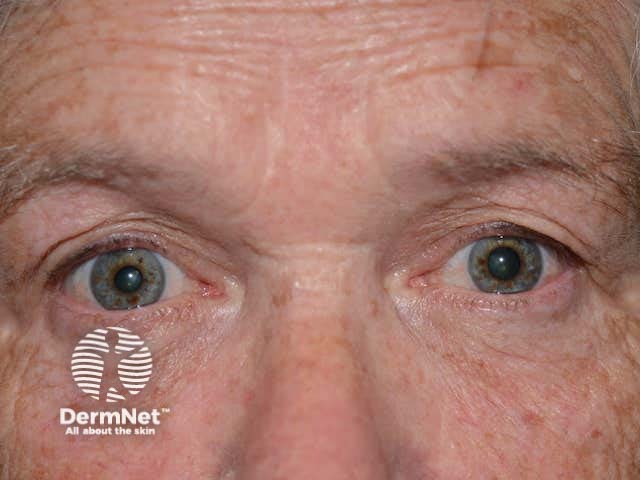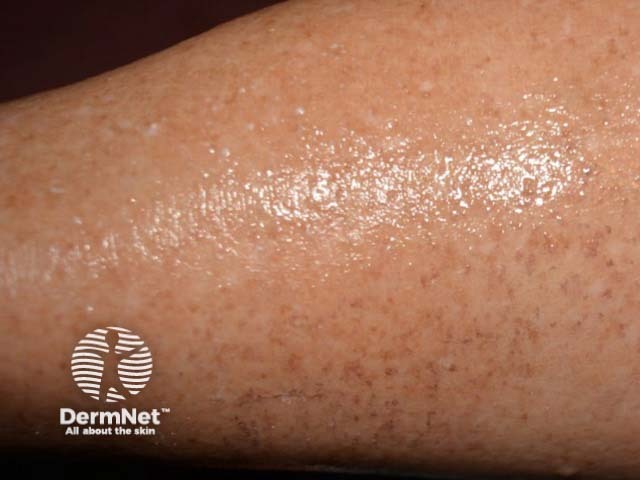Main menu
Common skin conditions

NEWS
Join DermNet PRO
Read more
Quick links
Author(s): Dr Monique Mackenzie, Dermatology Registrar, Auckland City Hospital, Auckland, New Zealand; Dr Marc Lawrence, Dermatology Registrar, Auckland City Hospital, Auckland, New Zealand. Copy edited by Gus Mitchell. October 2020.
Introduction Demographics Causes Clinical features Complications Diagnosis Differential diagnoses Treatment Outcome
Ross syndrome is a rare peripheral autonomic nervous system disorder characterised by three features: tonic (Adie) pupil(s), reduced or loss of deep tendon reflexes (hyporeflexia or areflexia), and segmental anhidrosis.
Ross syndrome can occur in any age group, sex, or racial background. The most common age at presentation is 25–50 years. There has been a slight male predominance in reported cases, although numbers are small.
The exact cause of Ross syndrome is unknown. Skin sympathetic fibre dysfunction is the primary proposed mechanism of disease. Studies have shown a relative absence of cholinergic sudomotor fibres in the skin, yet the sweat glands themselves look normal. There also appears to be a loss of regulation of skin blood flow resulting in upper dermal blood vessels being large and dilated.
Tonic pupil results from damage to the ciliary ganglion or postganglionic parasympathetic nerve fibres. The cause of the reduced or absent reflexes is unknown.
ANA positivity has been reported in a small percentage of cases of Ross syndrome, raising the possibility that the condition may be autoimmune-related, but the relevance of the finding is being questioned.
Genetics may also play a role in the pathogenesis of this condition, having been reported in a pair of identical twins.
A 2020 study suggests Ross syndrome is an α-synucleinopathy after detecting the accumulation of α-Syn in autonomic nerve endings.
The first sign of Ross syndrome is usually the disturbance in sweating, and this is a mandatory requirement for making the diagnosis. Most patients present with patchy localised hyperhidrosis, unaware of the areas of anhidrosis. Hyperhidrosis in Ross syndrome is a compensatory mechanism usually involving unilateral segments most commonly on the trunk between the T5 and T12 dermatomes. Excessive sweating can also occur on the buttocks, legs, and face. Hyperhidrosis is most noticeable in humid or hot environments or during physical activity.
Some patients do however present because they notice the lack of sweating in an area of skin. There have been reports of alterations in skin pigment, such as hyperpigmentation in areas of hyperhidrosis and hypopigmentation of anhidrotic skin. Skin surface temperature differences can also be detected. Rarely, loss of goose-bumps and an inability to shiver may be elicited on questioning; patients may describe never feeling cold.
The second most consistent sign is a reduction or loss of deep tendon reflexes found on neurological examination.
Incomplete Ross syndrome may not show the constricted tonic pupil(s) on initial presentation, although it is sometimes the reason for seeking medical attention. This feature may present clinically as anisocoria (pupils of different size). Tonic pupil usually affects one pupil first, before becoming bilateral with time. The pupil fails to change size on exposure to light but shows the normal size change when accommodating from far vision to close. Vision is usually normal.

Anisocoria in Ross syndrome

Hyperhidrosis

Segmental hyperhidrosis demonstrated by blue discolouration on Minor test
Excessive sweating impacts quality of life, and can severely affect the ability to carry out physical work or exercise. Patients often report needing to change their clothing several times a day, and seek cooling measures such as taking a cold shower or using ice packs to cool down. Hyperthermia due to extensive anhidrosis is a significant medical complication leading to heat exhaustion and heat stroke; the extent of anhidrosis can progress with time in Ross syndrome.
Progressive disease can lead to further autonomic dysfunction, including cardiovascular symptoms such as inappropriate tachycardia and postural hypotension. Peripheral neuropathy, diarrhoea, constipation, urinary urgency, and incontinence are also reported.
Diagnosis is usually clinical, based on the typical triad of features, although incomplete Ross syndrome presenting with only the abnormalities in sweating and areflexia is common early in the disease course.
Investigations to confirm the diagnosis may include a corn starch–iodine sweat test (Minor test), punch biopsy of the skin looking for reduced sweat gland complexes, and sympathetic skin response (SSR) electrophysiology studies.
Investigations may be required to exclude other diagnoses.
Systemic causes of tonic pupil include diabetes mellitus, thyroid dysfunction, Sjögren syndrome, and syphilis. Disorders of sweating may also mimic Ross syndrome.
These conditions show overlapping features with Ross syndrome:
Therapeutic options for Ross syndrome are similar to primary or secondary hyperhidrosis. General cooling measures include wearing loose clothing and avoiding hot environments or heavy exertion. Wearing wet clothing may minimise the risk of hyperthermia due to anhidrosis if excessive heat or physical activity cannot be avoided.
Antiperspirants containing aluminium chloride 10–25% are used to prevent excessive sweating.
Anticholinergic medications including oxybutynin and glycopyrrolate inhibit the effect of acetylcholine on the sweat glands. While they can be useful to reduce sweating, there are side effects, including dry mouth, blurred vision, constipation, and urinary retention. Botulinum toxin injections, iontophoresis, and sympathectomy, have also been used in the treatment of severe hyperhidrosis.
A delay in diagnosis is common, either due to a failure to present, or a failure to consider the diagnosis. Ross syndrome is a benign condition, not life threatening, but autonomic symptoms are likely to be slowly progressive.